Want to see the effects of discounts on Steam and itch.io? You’ve come to the right place.
This data is from Abridge‘s first 5 months of discounts. Covers the discount results, the discount strategy, and the strategy’s effectiveness on Steam and itch.io.
Let’s start with the results!
Abridge’s Discount Results Fact Sheets
- 60% of the units sold were at a discount
- Total: 86
- Steam: 77
- itch.io: 9
- Discount units accounted for 55% of total revenue
- Total: $345
- Steam: $296
- itch.io: $49
- Steam discounts outperform itch.io discounts
- 8.5x in discounted units
- 6x in discounted unit revenue
- The launch discount was best discount in discount units and discount unit revenue on Steam and on itch.io
- For Steam
- Accounted for 56% of total discounted units
- Accounted for 59% of total discounted unit revenue
- For itch.io
- Accounted for 78% of total discounted unit and discounted unit revenue
- For Steam
- Ratio of discounted units to total discounted units was the same on Steam and on itch.io (60%)
- Itch.io’s discounted unit revenue per discount unit is 39% higher than Steam’s
- Discount “tail” of Steam is better than itch.io (i.e. Sold more discounted units over time)
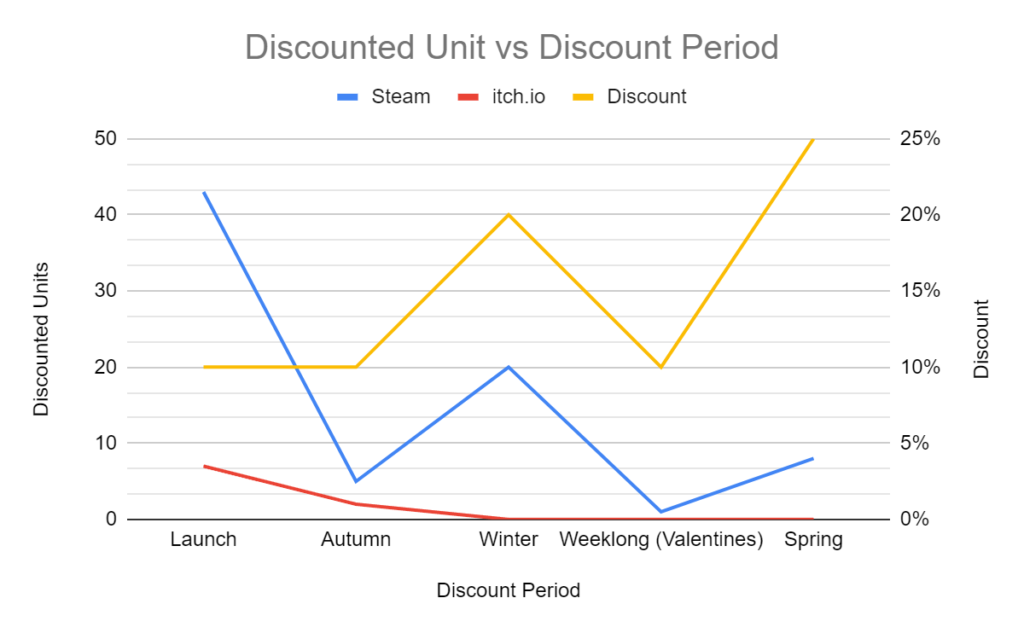
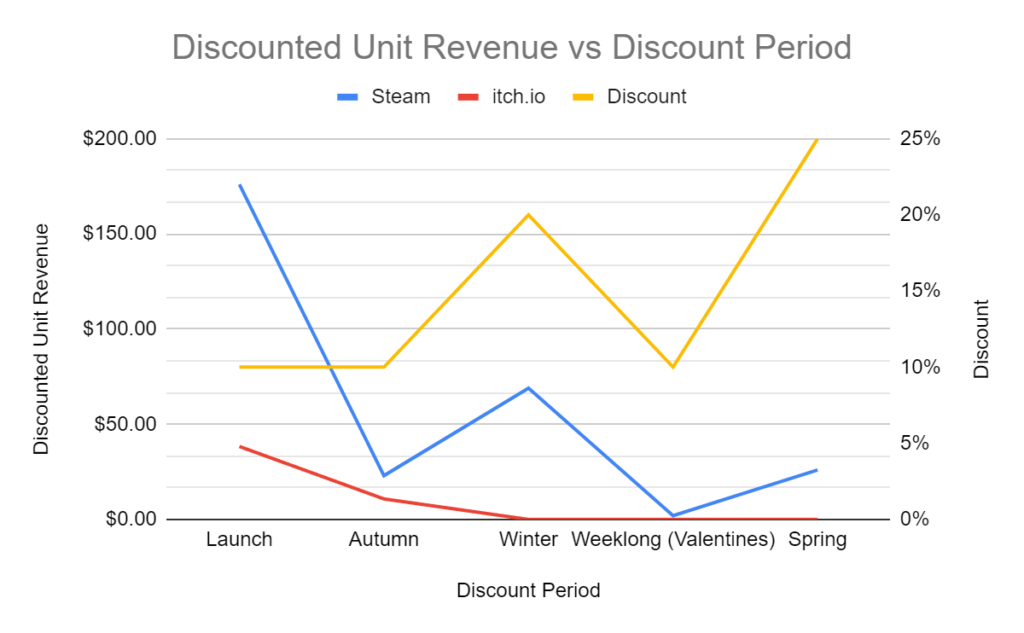
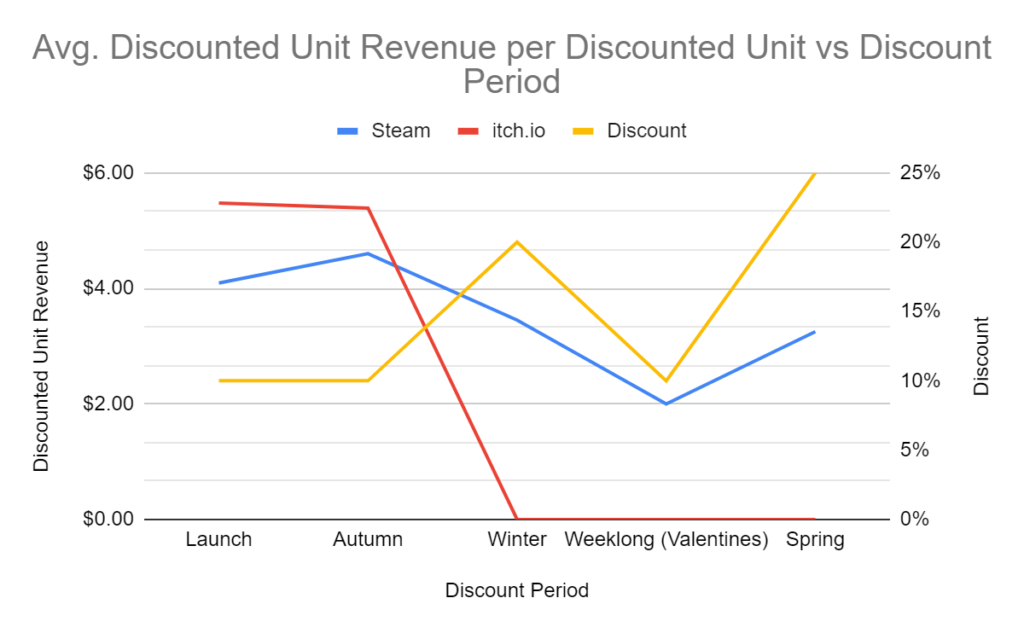
Discount Strategy
This was my discount strategy for the first 5 month of Abridge’s Release:
- Do a launch discount
- Oscillate between a low discount and a high discount after launch discount
- Each high discount is a new all time high each time
- Take every discount opportunity
- Match discount and discount duration on Steam and on itch.io
Did the discount strategy work?
On itch.io, no. On Steam, Yes.
What’s interesting is that it failed on itch.io and succeeded on Steam for the same reason: the platform’s culture.
Why didn’t the strategy work on itch.io?
Players don’t come to itch.io for the discounts.
They come for game jams, play interesting and unique indie games, or buy games as alternatives to Steam. The first two reasons far outweigh the third and they are also free.
As a result, trying to incentivize players to come to make purchases at a discount doesn’t work. It’s not the reason they come. They come to play, not spend money. If they do buy the game, it’s only close to release. Otherwise, they don’t come back.
Why did the strategy work on Steam?
Steam builds it’s culture around discounts. They offer whole festivals and “seasons” dedicated them.
Players look forward to these events each year. They give players a reason to keep coming back. Is that one game finally available for a good price? Only one way to find out.
Since these discount periods are consistent, players leverage the wishlist system to manage the games they are interested in. When these discount periods arrive, the wishlist system turns into a notification system. It lets them know the games they liked earlier are discounted right now. The discounts again drive them back to Steam. This is another reason why wishlists are important post game release.
All Steam’s systems and events aim to drive you to Steam, keep you there and keep you coming back. All in this nice synergistic package to buy games.
As a result, each time I had a new high discount, it generated more sales than the low discount. Players kept coming back because of these events, notification, and discounts. Leading to a longer discount tail.
Closing Comments & Caveats
The sample size I am dealing with is small. More time and data will give a better and clearer picture.
Be aware that all discounts are being tracked. Not only by Steam but third party sites, such as Isthereanydeal.com. I’ve used it to research if the discount offered is actually good.
Note that once you give a discount that is all time high, that becomes the new standard. No going back.
Higher discounts don’t always lead to higher sales. This reigned true for my experience. But that’s not always the case. Martin from Daisy Games shared his experience in this tweet. It was different from mine.
“Nobody on Steam buys games at full price” says Chris Zukowski in his blog article, “4 Tips to Help you Price your Indie Game”. As a gamer, this is true. I am aware that if I wait, a game’s prices will go down. As a dev, I keep this in the back of my mind during development. When I was ready to price Abridge, I was glad I followed his advice. Increasing the base price by 20% to combat discounts. Allowed me to make higher discounts and generate more revenue vs not following it.
For promotion, advertisement and marketing, I did most of it at launch and for the first discount. Emails to YouTuber, Twitter, Reddit, and Discord. After, I didn’t push awareness as much or even at all. Reduced down to sharing Twitter.
Don’t have a big following or community (… or ,at least, not yet 😉).
Don’t be afraid to have a strategy and/or change it. It’s better to have a strategy and check if it works than to not have one at all. I don’t know what works. Need to start somewhere. I am planning to change up my discount strategy. Plan to share the differences later too.
Summary
Discounts on itch.io and Steam result in different outcomes. Players on Steam are responsive while players on itch.io are not. The reason is the difference is the platform’s culture.
Players on itch.io don’t come for the discounts. They come for game jams and indie games. Both of which are free.
Steam revolves around discounts. They have dedicated festivals and seasons for them. The wishlist system transforms into a notification system when these discount periods arrive. Both of these and the discount itself incentivize the players to come back to Steam and buy games.
That’s it! Have more questions about the blog? Come and join my discord. Love to chat and answer what questions you have.
Want to hear when the next blog is out? Sign up for my email list here.
Share the blog with a friend, gamer or a fellow game dev.
Cheers!



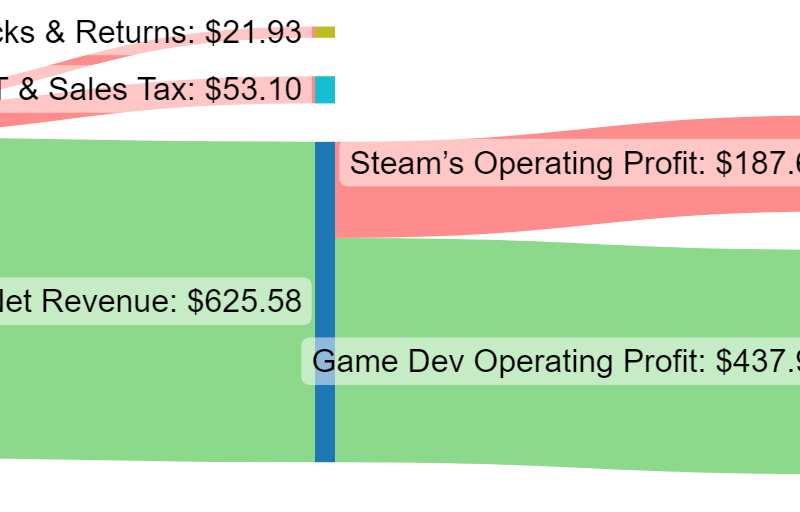
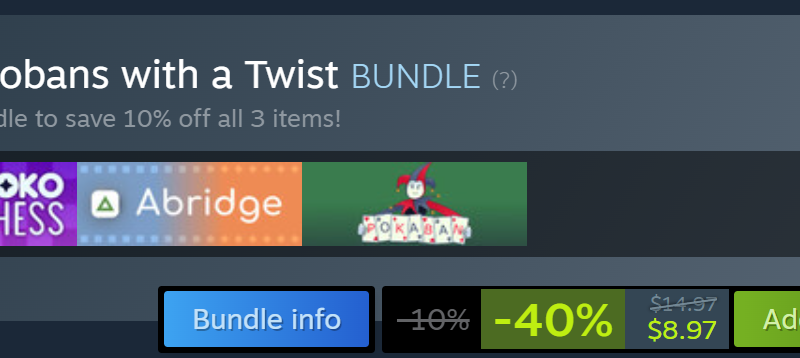
It’s great that you are getting ideas from this post as well as from
our discussion made at this place.
It’s wonderful that you are getting thoughts from this article as well as from our argument made at this time.
hello there and thank you for your information – I have certainly picked up something new from right here.I’m adding this RSS to my email and can look out for much more of your respective fascinating content.